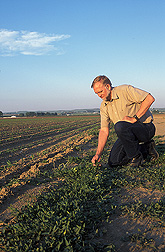This page has been archived and is being provided for reference purposes only. The page is no longer being updated, and therefore, links on the page may be invalid.
Read the magazine story to find out more. |
|
Soil Is Key to Effective Weed Management
By Laura McGinnisAugust 16, 2006
The fight against weeds is getting dirty.
At Fort Collins, Colo., scientists with the Agricultural Research Service (ARS) are turning to soil to promote weed control.
Soil variability, an important factor in treating weed-infested fields, can be gauged by measuring different soils' electrical conductivity (EC). A soil's EC assesses how easily it allows a current to pass through it. Soils with a higher EC generally have more clay and organic matter and require more herbicide.
Farmers can use EC to create herbicide application maps, allowing them to adjust application rates based on variations within the soil. This, in turn, reduces the risk of excessive herbicide leaching while maintaining effectiveness.
Herbicide selection is an equally important aspect of weed control. Dale L. Shaner, a plant physiologist in the Water Management Research Unit at Fort Collins, has shown that atrazine, a widely used herbicide, sometimes breaks down rapidly in fields where it has been used for many years. This could be the result of bacteria which reduce the herbicide to its elemental parts.
Herbicide degradation makes weed control difficult, so farmers have to spend more time and money to apply additional herbicide. An inexpensive field kit could help farmers and crop consultants identify whether fields are at risk before they apply atrazine.
Shaner and his colleagues are investigating whether test strips used to analyze water for atrazine's presence could be modified to test the soil. Though a field kit is still in the early stages of development, Shaner believes it could help reduce herbicide overdose.
Read more about this research in the August 2006 issue of Agricultural Research magazine.
ARS is the U.S. Department of Agriculture's chief scientific research agency.

